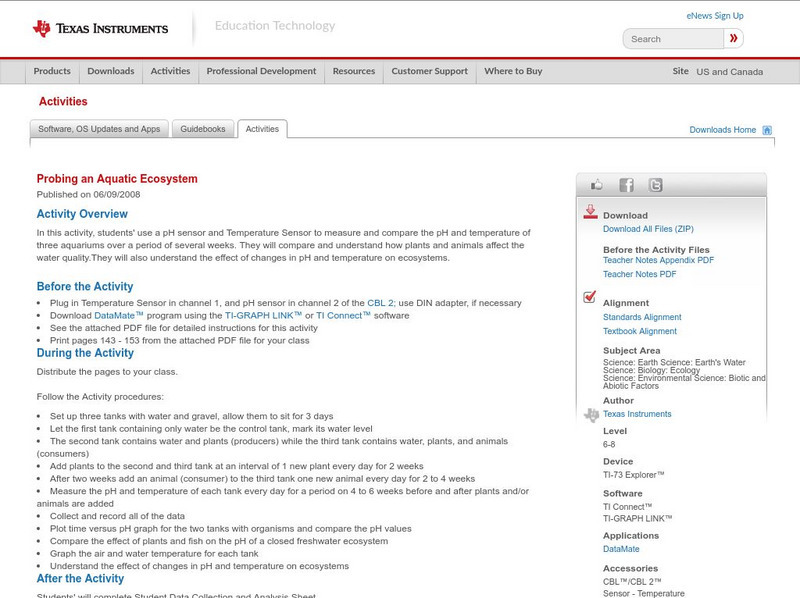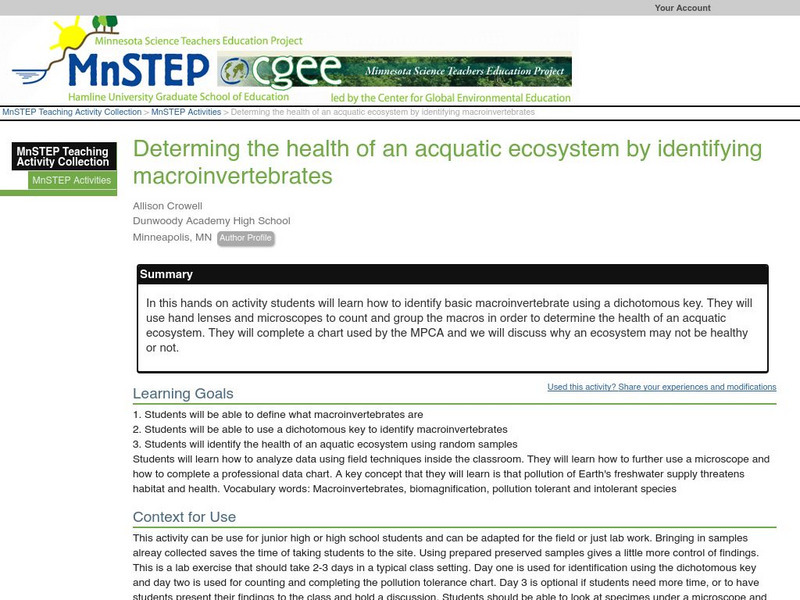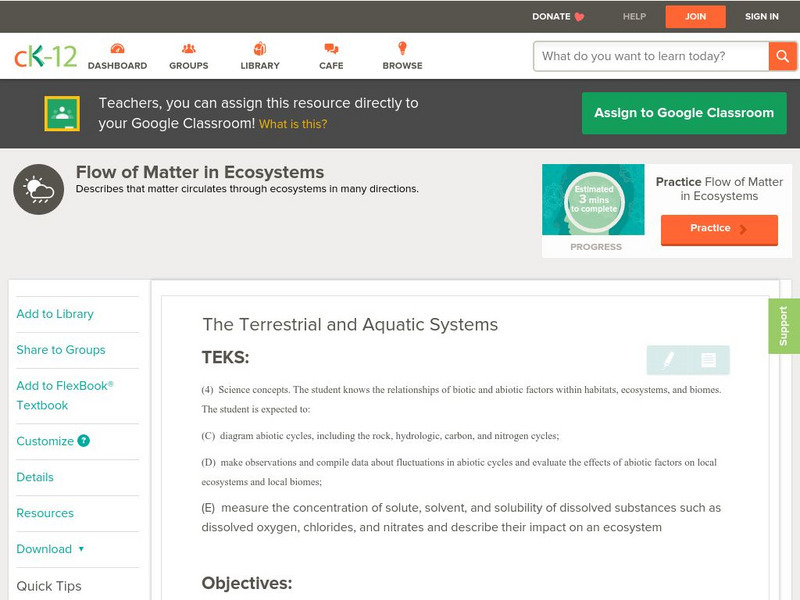Curated OER
How Much Water is in That River?
Students practice measurement using the Hudson River. They calculate the discharge measurement at a location on the Hudson River using ingenuity and a topographic map.
Curated OER
Life In Extreme Environments
Students work together to design and participate in experiments to determine the rate rotifers eat. After completing their experiments, they record and analyze their data and identify any challenges faced during the procedure. They...
Curated OER
Fishing
Students explore the techniques and basic needs of the fisherman. For this fishing lesson, students view a demonstration of the use of fishing equipment. Students research Iowa farm ponds and design a class mural from their...
Curated OER
Estuaries, Estuarine Habitats, and Adaptations
Pupils conduct research on estuaries. They design and construct an estuary, describe the physical characteristics of an estuary, and create a diagram illustrating an estuarine food web.
Curated OER
Climate Change-Boon or Bust for Northern Waters?
Students explore about and evaluate the potential impacts of climate change on northern hydrological systems. They work in small groups, research the background to climate change in the north with a particular focus on lakes and rivers.
Curated OER
Hawaii's Freshwater Animals - Species Report
Learners explore biology by creating a report for the class. In this oceanography lesson, students research and identify the survival characteristics of a list of freshwater animals by utilizing the Internet and library. Learners...
Curated OER
Who Lives In The Water
Learners investigate the environment of a stream or lake to collect and observe macroinvertebrates in their natural environment. They record data and summarize the information obtained. Students look to see if there has been any human...
Curated OER
Temperature and Brine Shrimp Eggs
Students determine the optimal temperature at which brine shrimp eggs hatch and develop. They evaluate the changes, if any, which occur in a brine shrimp culture at various temperatures.
Curated OER
Wacky Water Critters
Learners visit a local creek or stream. They collect water samples from the creek and observe and sort the "water critters" they find in the sample, observing smaller organisms under a microscope if necessary. They identify each organism...
Curated OER
Life in the Kelp Forest
Students research and create a marine food web to learn about plants and animals in a kelp forest. In this marine food web lesson, students draw lines between kelp forest predators and prey and show the flow of energy in the food web....
Curated OER
Invasive Species
Pupils study exotic and native species, and examine how exotic species can impact native ones. They study how the mute swan effects native species.
Curated OER
Mold
Students explore mold, the different types and the health risks that they pose. In this mycelium lesson students grow different molds and see which type of foods mold the fastest.
Curated OER
Relating Number of Insect Species to Water Quality
Students are asked to respond to questions such as:" Have there been surveys of the area to inventory the species?" (For example, for a wetland area, do they know what amphibians live there and how abundant they are?) Are there any...
Curated OER
Water Quality Survey: Monitoring the Sustainability of Pigeon Creek
Students research the History of Pigeon Creek (or any watershed in your area). In this environmental science lesson plan, students conduct field tests such as pH and nitrates. They collect data and compare what they collected with other...
Curated OER
Mussel Movements
Learners consider the impact of invasive species on local environments. In this ecology instructional activity, watch the video, Arizona Wildlife Views, which focuses on invasive species. Students develop vocabulary, relate to meaningful...
Curated OER
Urban Impact on Chollas Creek (California): A Field Study
Students, in groups, take samples from a creek and keep a field journal on their samples. They also perform tests on their samples.
Curated OER
Build a Bug
Students design an ideally adapted macroinvertebrate to live in a water habitat. They illustrate their animal, name it and specify the adaptations it has that enable it to survive.
Science Education Resource Center at Carleton College
Serc: Investigating Aquatic Ecosystems: Macroinvertebrates and Water Quality
Students will investigate three aquatic ecosystems (pond, stream, bog) to determine the relative pollution index and the water quality of each ecosystem. They will collect and analyze the benthic organisms found in each system and...
Texas Instruments
Texas Instruments: Probing an Aquatic Ecosystem
In this activity, students' use a pH sensor and Temperature Sensor to measure and compare the pH and temperature of three aquariums over a period of several weeks. They will compare and understand how plants and animals affect the water...
Science Education Resource Center at Carleton College
Serc: Identifying Macroinvertebrates to Determine Health of Aquatic Ecosystem
In this hands on activity students will learn how to identify basic macroinvertebrate using a dichotomous key. They will complete a chart used by the MPCA and we will discuss why an ecosystem may not be healthy or not.
Science Education Resource Center at Carleton College
Serc: Mn Step: Stream Study: An Investigation of an Aquatic Ecosystem
For this activity, students visit a local stream over a 9-week period to take measurements of its chemical and physical attributes, and collect information about the life forms it supports. After exploration, they will choose what they...
CK-12 Foundation
Ck 12: Earth Science: Flow of Matter in Ecosystems
[Free Registration/Login may be required to access all resource tools.] In this module, students will learn about the cycles of nature (water, carbon, nitrogen, and phosphorus) that support the flow of nutrient matter through an...
Other
Project Wild: Aquatic Times [Pdf]
Teach students to be more aware of issues surrounding aquatic animals and their habitats. Includes lesson, extension activities, and evaluation ideas.
PBS
Pbs Learning Media: Acid Lake
Students will add acidity to a healthy lake to see what happens to plants and animals in this interactive activity adapted from EcoKids.






















![Project Wild: Aquatic Times [Pdf] Lesson Plan Project Wild: Aquatic Times [Pdf] Lesson Plan](https://static.lp.lexp.cloud/images/attachment_defaults/resource/large/FPO-knovation.png)